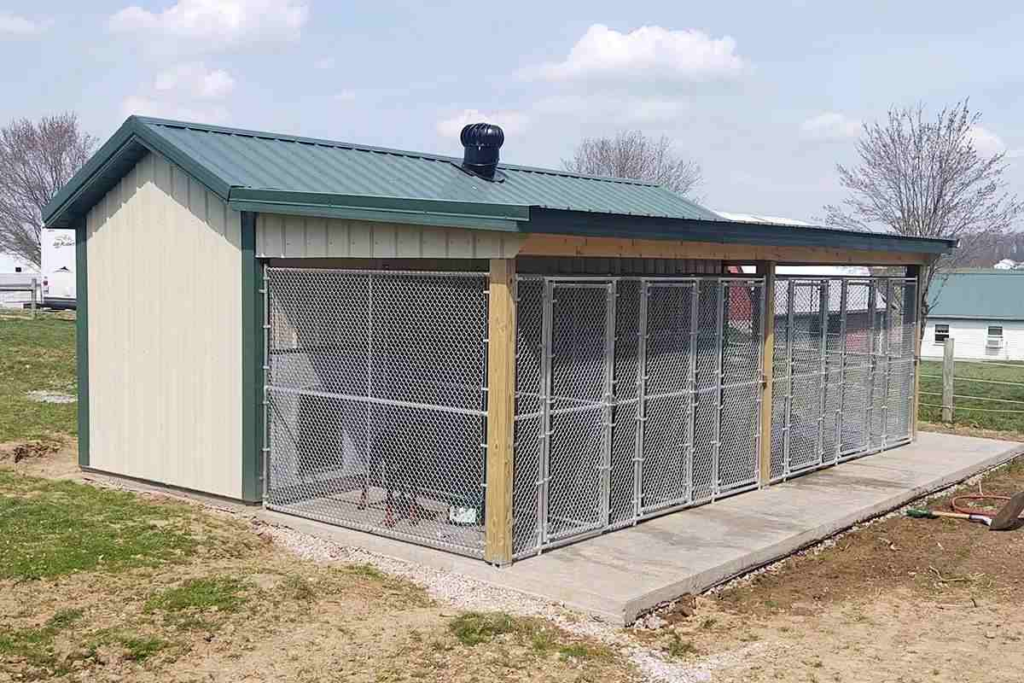Developing top upland and waterfowl dogs takes time and commitment, and the keys to raising and training a dog involve more than just training sessions and time in the field. Nutrition is an important consideration for your hunting dogs, and routine veterinary care is also important.
Another important aspect of gun dog ownership is where the dog will live. Some owners prefer to keep their dogs in the house, and that arrangement works fine if you have one or two dogs. But breeders, field trialers, and trainers will likely need outdoor space where they can keep dogs outside. In these situations, you need to be certain that your outdoor facilities offer dogs a safe, comfortable home that is protected from the elements.
I reached out to Brandon Troyer, owner and sales manager at KT Custom Barns in Millersburg, Ohio, for his advice on dog kennel design. Founded by his father in 2001, KT Custom Barns has built hundreds of horse barns, dog kennels, bird coops, small animal barns, and other items for customers in Ohio and surrounding states over the years Troyer and his team understand which elements of dog kennel design are most important so that your canine companions are safe and sheltered and that owners have sufficient space for storage, whelping, indoor training, or anything else they need. Here are some of the elements you’ll need to consider when building your ultimate outdoor dog kennel.
When working with customers, Troyer says that the conversation typically begins with how many dogs the owner will have at one time. Generally speaking, the space required for a single owner with a couple dogs is considerably less than the space required for a trainer, lodge owner, or breeder.
“The conversation generally starts with a question about how many dogs need to be housed and whether they will live in the space year-round,” Troyer says. A friend and fellow upland hunter lives with his setters in his house in a subdivision, but he owns property where he hunts and trains his dogs. There are kennels on his second property, but because dogs are only staying in those kennels temporarily (generally between hunts or training sessions) they are more spartan than most year-round kennels.
Troyer also says that you will need to decide if your dogs will have indoor or outdoor living space or both. KT Custom Barns offers buildings that include both indoor and outdoor runs, and these facilities offer dogs the option to come inside to escape the weather and the additional space and fresh air afforded by outdoor kennels.
All outdoor kennels need to offer some level of protection against the elements. For some, this might simply be a canopy for shade and an insulated doghouse, but in many cases, it makes sense to offer dogs an indoor barn area where they can escape cold temperature, wind, and precipitation. Plus, having indoor/outdoor kennels is generally more pleasant for the dogs.
“We generally insulate our barns and then add fiber board,” Troyer says. “The fiber board is especially important for dogs because it’s easy to clean and dogs can’t chew on it.” Glued fiber board doesn’t offer any protruding edges that a dog can bite or chew, and this is important because if you own bird dogs, sooner or later you’ll end up with one that chews. Such a dog can rearrange the interior of its indoor kennel space in short order, and no owner is happy to see costly insulation and cover materials tattered and laying on the interior of the kennel.
If your bird dogs will spend extended periods of time in their kennel, it’s important to offer them ample space to move. Hunting dogs tend to be high-revving breeds requiring lots of movement and offering them enough space to burn off some of their stored energy is important. A kennel that offers outdoor space where a dog can move, play, lounge in the warm sun, and watch the world pass by is good for their active canine brain. It’s also less expensive to add outdoor space than indoor space.
A kennel that is completely outdoors does need to offer protection from the elements, and at the very least that should be an insulated doghouse with ample clean, dry bedding in moderately cold climates. Dogs are very tough animals, but they should not be exposed to harsh elements. You should also consider the prevailing wind and direction of the sun when choosing a kennel site. If winter winds come from the northeast, that’s not the best direction to face your kennel and the opening to a doghouse. You can also use existing structures as buffers for your kennels. I built outdoor kennels on the side of my detached garage so that they were protected from prevailing winds in most cases and were not exposed to direct sunlight all day. This also made it simple to provide them access to interior space via dog doors.
Kennels that are completely housed within a structure are fine, but there are drawbacks to this design. For starters, you’ll have to deal with odor and noise. If you’ve ever walked into the indoor kennel area at an animal shelter you understand how incredibly noisy these spaces can be. Multiple dogs barking inside a structure is head-rattling (for dogs and people). Kennels must be cleaned very often to cut down on odors. A floor drain system can help with this as it makes it easier to clean kennels with water. You’ll also need some way to regulate temperature. A small, insulated building with little or no air movement can be stifling in summer.
The best option for serious owners is likely indoor/outdoor space. This is particularly important for breeders, Troyer says, as it offers a whelping area that is secure and protected. KT Custom barns offers kennels with four-by-six foot outdoor runs attached to their barns, and this provides dogs with more room to move while maintaining indoor space for dog food, supplies, and medicine. If I were building my indoor/outdoor kennels again, I would add an interior drain system with water which would simplify cleaning the interior space.With a water hookup and drains, it would be easy to add a bay for washing dogs.
Interior temperature can be controlled in a variety of ways. If you have a large kennel space and the budget, a mini-split is an outstanding option. These operate with a heating/cooling unit outside the kennel and there is a compact wall mount inside. Small electric heaters can increase interior temperatures on cold winter days, and fans can reduce temperatures on warm days.
Inside or out, it’s important to provide some type of stable flooring for dogs. Concrete flooring is the most popular choice, Troyer says, and I have had good luck with my kennels. Concrete is easy to clean and is much more comfortable for dogs than limestone gravel.
Galvanized wire is the most popular choice for kennel panels, Troyer says, but you should consider whether you want dogs to be able to see one another. Troyer says that some owners want to be able to shield neighboring dogs, so there needs to be a simple method to do so (simply hanging a tarp that is accessible to the dogs generally doesn’t provide satisfactory results—what it does provide is a shredded tarp). Designing kennels so that a barrier can be placed between dogs if necessary is a good idea, and one that you need to consider before construction starts. Troyer says his company prefers to install polymer dividers which are effective, relatively affordable, and durable.
Budget is a concern, of course. Troyer says their custom dog barns average around $8,500, but that offers insulated interior space. You can certainly build your own kennel for less, but before you begin, you need to determine exactly what features are most important to you as well as your craftsmanship skills and limitations. With proper planning you can design a fantastic outdoor kennel that makes life better for you and your four-legged hunting partners.
Get everything Gun Dog has to offer. What’s Included
Subscribe Now
Already a subscriber? Sign In
or start your online account
Get everything Gun Dog has to offer. What’s Included
Subscribe Now
Already a subscriber? Sign In or start your online account
See All From Recipes
See All From Gun Dog
See All From Gear


All Gun Dog subscribers now have digital access to their magazine content. This means you have the option to read your magazine on most popular phones and tablets.
To get started, click the link below to visit mymagnow.com and learn how to access your digital magazine.
Get Digital Access
Gun Dog Premium is the go-to choice for sporting dog owners and upland hunting enthusiasts. Go Premium to recieve the follwing benefits:
Subscribe Now
Already a subscriber? Sign In or Start your online account
Subscribe Now
Already a subscriber? Sign In or Start your online account

